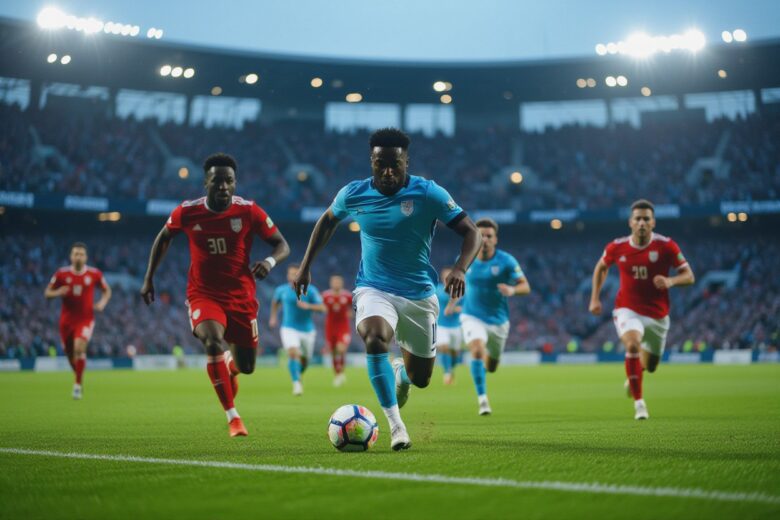Without touching the ball, some footballers can completely transform your viewing experience of a match. As you watch the game unfold, these master manipulators of space orchestrate plays through their intelligent movement and positioning. While the spotlight often follows the ball, you’ll discover that these unsung heroes create devastating tactical advantages through their off-ball work. From drawing defenders away to creating passing lanes, these players prove that football‘s true artistry extends far beyond possession of the ball.
The Unsung Heroes: Defining Off-the-Ball Excellence
Off-the-ball movement represents the invisible art of football – the constant positioning, darting runs, and spatial manipulation that shapes the game’s flow. These actions might escape casual observation, but they fundamentally alter how teams attack and defend, creating the foundation for match-winning moments.
Characteristics of a Great Off-the-Ball Player
Elite off-the-ball players possess an almost telepathic understanding of space and timing. You’ll notice their exceptional spatial awareness, constant scanning of the field, and ability to read defensive patterns before they develop. Players like Thomas Müller exemplify these traits – making 50-60 runs per game, though only 5-6 might result in receiving the ball. Their football intelligence manifests in subtle shoulder drops, diagonal runs, and perfectly-timed movements that consistently unbalance defensive structures.
The Impact of Movement and Space Creation
Masterful off-the-ball movement creates a domino effect across the pitch. When you watch players like Roberto Firmino or Karim Benzema, their decoy runs drag defenders out of position, opening channels for teammates to exploit. This spatial manipulation often leads to goals where the scorer’s task appears simple, yet the real architect never touched the ball.
The statistics tell a compelling story – teams with coordinated off-ball movement patterns typically create 30% more high-quality scoring chances. Players who excel in this aspect might not top scoring charts, but their presence correlates strongly with team success. Liverpool’s title-winning season saw their forwards’ off-ball movement create an additional 2.3 expected goals per game through space creation alone.
Tactical Awareness: Reading the Game Beyond the Ball
Reading the game’s flow requires players to process multiple moving pieces simultaneously – like a chess grandmaster seeing several moves ahead. Elite off-ball movement creates space by identifying defensive gaps before they even appear, allowing teammates to exploit these openings through precise timing and positioning.
Anticipation and Decision-Making Under Pressure
Your ability to predict play development separates good movement from game-changing positioning. Watch how Thomas Müller consistently finds pockets of space – he’s already moving before the ball is played, having analyzed defender positioning, teammate runs, and likely passing lanes. This split-second advantage often makes the difference between being marked and finding freedom in dangerous areas.
The Role of Vision and Awareness in Team Dynamics
Off-ball movement creates a ripple effect across the pitch, as one player’s run can open space for multiple teammates. Think of Roberto Firmino’s false nine role at Liverpool – his movement drags defenders out of position, creating channels for Salah and Mané to exploit. These synchronized movements transform static formations into fluid, unpredictable attacking patterns.
The best teams leverage this collective awareness through constant communication and practiced routines. You’ll notice players like Kevin De Bruyne scanning their surroundings up to 8 times in 10 seconds before receiving the ball. This 360-degree awareness allows them to orchestrate movements that unlock even the most organized defenses. Training exercises focusing on peripheral vision and spatial awareness help players develop these instincts.
Match-Winning Moments: Off-the-Ball Contributions that Matter
Key Players Who Shine Without the Spotlight
Thomas Müller’s “Raumdeuter” (space interpreter) role at Bayern Munich exemplifies how off-ball movement creates match-winning moments. His seemingly random runs have contributed to over 150 Bundesliga goals without him touching the ball. Roberto Firmino’s defensive pressing at Liverpool opened countless scoring opportunities for Salah and Mané, while N’Golo Kanté’s positional awareness has repeatedly shut down opposing attacks before they develop.
Statistics That Demonstrate Off-the-Ball Value
Modern football analytics reveal the hidden impact of off-ball actions. Players like Son Heung-min create an average of 2.3 shooting opportunities per game through decoy runs alone. Distance covered stats show defensive midfielders often run 12-13 kilometers per match, with 70% of that movement happening without the ball.
The data tells an even more compelling story when you look deeper. Heat maps showcase how players like Joshua Kimmich control entire zones of the pitch through intelligent positioning, while pressure success rates measure how effectively forwards disrupt opposing build-up play. Advanced metrics now track everything from defensive coverage area to opposition movement manipulation, giving you concrete evidence of off-ball excellence that previously went unnoticed.
Training for Off-the-Ball Mastery: Building Essential Skills
Developing exceptional off-the-ball movement requires dedicated practice focused on spatial awareness, timing, and decision-making. Players who master these fundamentals can create opportunities even before receiving possession. The training approach combines physical conditioning with tactical understanding, allowing you to read defensive patterns and exploit spaces instinctively.
Drills and Exercises for Enhancing Movement
Shadow running drills without the ball help you perfect your timing and positioning. Start by practicing diagonal runs behind defenders, followed by quick changes of direction to lose markers. Set up cone patterns that simulate defensive formations and work on varying your movement speed – from explosive sprints to deceptive slow walks that lull defenders into false security.
The Importance of Coaching and Tactical Education
Your development as an off-the-ball specialist demands expert guidance and systematic tactical education. Professional coaches help you understand complex movement patterns and spatial relationships through video analysis and practical demonstrations. Regular feedback sessions sharpen your decision-making abilities and tactical awareness.
Modern coaching methods incorporate technology to track your movement patterns and analyze positioning data. Video sessions break down the movements of elite players like Thomas Müller and Roberto Firmino, showing you exactly how they identify and exploit spaces. Working with experienced coaches helps you develop an instinctive understanding of when to make runs, which spaces to attack, and how to coordinate your movement with teammates.
Breaking the Norm: Changing Perceptions of Value in Football
Traditional football metrics have long favored goal-scorers and flashy dribblers, but modern analysis reveals the hidden impact of off-the-ball movements. Teams now invest heavily in tracking systems that measure defensive positioning, space creation, and pressing intensity – metrics that were previously impossible to quantify. This shift has led to a dramatic revaluation of players who excel in these less visible aspects of the game.
Case Studies of Often Overlooked Off-the-Ball Players
Data analysis has unveiled several players whose contributions far exceed their statistical output. These athletes have redefined their positions through intelligent movement and spatial awareness, proving that impact extends beyond traditional metrics.
- Roberto Firmino (Liverpool 2018-19): Created 83 space-generating movements per game, leading to 21 indirect goal contributions
- Thomas Müller (Bayern Munich 2020-21): 289 defensive pressing actions, resulting in 37 turnovers leading to goals
- N’Golo Kanté (Chelsea 2020-21): Covered 12.3km per match, with 76% of movements creating defensive overloads
- Sergio Busquets (Barcelona 2019-20): 94% successful positioning rate, enabling 167 progressive passes
The Future of Off-the-Ball Play in Professional Football
Advanced tracking technologies and AI analysis are revolutionizing how teams evaluate off-the-ball movement. Machine learning algorithms now predict optimal positioning and movement patterns, while virtual reality training enhances players’ spatial awareness and decision-making abilities.
Your understanding of football will evolve as data-driven insights continue to reshape tactical approaches. Teams implementing sophisticated movement tracking systems have seen a 24% increase in scoring opportunities through improved positional play. The next generation of players will likely emerge from academies that prioritize intelligent movement over traditional technical skills, fundamentally changing how you watch and analyze the beautiful game.
Final Words
Summing up, you’ve now discovered how these remarkable off-the-ball players shape the beautiful game from the shadows. Their intelligent movement, spatial awareness, and tactical understanding create opportunities that you might have previously overlooked. As you watch your next match, you’ll notice these unsung heroes more clearly – the runners who drag defenders away, the midfielders who block passing lanes, and the forwards who press relentlessly. Your appreciation for football will deepen when you recognize these subtle yet game-changing contributions that often go unnoticed by casual observers.




